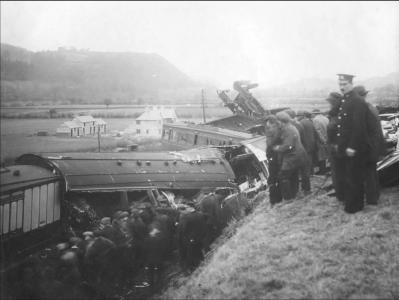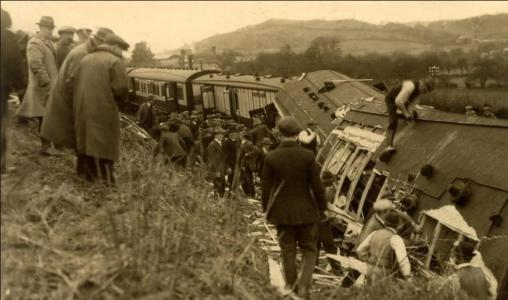1920-1940 Abdication
1920-1940 Abdication is in 20th Century Events.
Abermule Train Collision
On 26 Jan 1921 an express and stopping train collided at Abermule, Newtown.
Seventeen people were killed including Herbert Lionel Henry Vane-Tempest (age 58), a director of the railway.
"The driver of the down train was oiling his engine at the moment when the tablet holder was handed to his fireman by relief-stationmaster Lewis. It is clear that neither he nor the fireman could have examined the tablet before the train started from Abermule. It is also clear that neither Lewis, Jones, nor Thompson could have looked at the tablet instrument for the Abermule-Newtown section, otherwise they would have seen the indicator showed that a tablet had been withdrawn for an up train. After the down train had started (about 12.3 p.m.), presumably when he returned to the booking office to send the "entering section" bell signal for the down train to Newtown, and the "out of section" bell signal to Montgomery, the terrible mistake that had been made was discovered by Thompson, and Lewis realised that he had given the Montgomery - Abermule tablet to the down train. Lewis telephoned to Newtown to ask if the express had left, and was informed by Brock that it had left at 11.59 when he had sent the "entering section" bell signal. A vain attempt was made to attract the attention of the enginemen of the down train, by lowering and raising the up distant signal, but probably by the time this was attempted, the train had passed the signal post, about 660 yards from the loop points...
When [fireman] Owen recovered, he found himself on the ground just behind the second vehicle (No. 310) of his train, which was lying across the railway on top of the first. He saw driver Jones on the opposite side just behind and underneath the third vehicle, which was leaning over towards the slope of the cutting. He got across the framing, and found Jones more seriously injured than himself, and anxiously enquiring whether they had the right tablet. He assured him on the point, but a little later, as his driver was still anxious, he went to look for the tablet and crept under the frame of No. 7730 for the purpose. After a little search he found both tablet holders lying on the ground to the left (north) of the track alongside the wreckage of the two engines. He picked them up and found that one of the tablets for the Montgomery-Abermule section had evidently been carried by the down train. He then returned and showed them to his driver to relieve his anxiety. He subsequently handed the tablet holders to traffic controller Morgan, who travelled in the down train. Morgan eventually passed them for custody to chief traffic inspector George. The latter, immediately after the accident, returned on foot to Abermule, where he arrived at 12.18 p.m. and arranged by telephone for the dispatch of medical and nursing assistance from Newtown."
Herbert Lionel Henry Vane-Tempest:
On 06 Jul 1862 he was born to George Henry Vane-Tempest 5th Marquess Londonderry and Mary Cornelia Edwards Marchioness Londonderry.
The Times. 02 Feb 1905. The funeral of Lord Henry Vane-Tempest took place yesterday in the family vault in St. Peter's, Montgomeryshire. The Bishop of Bangor, assisted by the Rev J. Williams, rector of the parish, and the Rev. S. J. Evans, officiated. The principal mourmers were the Marquis and Marchioness of Londonderry (brother and sister-in-law), Lord Herbert Vane-Tempest (brother), and Mr. Beaumont, M.P., and Lady Aline Beaumont (brother-in-law and sister). Continues.
09 Feb 1915. Times Newspaper Obituaries. The news of the death of the Marquess of Londonderry, which occurred at Wynyard, Stockton-on-Tees, yesterday morning, will be received with profound regret far beyond the circle of his personal friends or of the members of the Unionist Party. Lord Londonderry had not been entirely well for some little time past. For a fortnight, it seems, he had been suffering from sciatica. Last week he caught a chill, from which pneumonia developed. On Sunday his condition was seen to be critical. During the night he collapsed, and the end came at 9.30 yesterday morning. Lady Londonderry, who had been in constant attendance on him during his illness, was present at the last, as also were Lady Ilchester and Lord Herbert Vane-Tempest.


Opening of Tutankhamun's Tomb
On 04 Nov 1922 the tomb of Tutankhamun 1341BC 1323BC was discovered by Howard Carter (age 48).
On 17 Feb 1923, at just after two o'clock, the seal of the Tomb of Tutankhamun 1341BC 1323BC was broken. Those present included Howard Carter (age 48), secretary to Lord Carnarvon Richard Bethel (age 40), George Edward Stanhope Molyneux Herbert 5th Earl Carnarvon (age 56), his daughter Evelyn Leonora Almina Herbert (age 21), Arthur C Mace, Assistant Curator of Egyptian Art at the Metropolitan Museum of Art, New York.
Wedding of George VI and Elizabeth Bowes Lyon
On 26 Apr 1923 King George VI of the United Kingdom (age 27) and Elizabeth Bowes-Lyon Queen Consort England (age 22) were married at Westminster Abbey [Map]. She the daughter of Claude Bowes-Lyon 14th Earl Strathmore and Kinghorne (age 68) and Cecilia Nina Cavendish-Bentinck Countess of Strathmore and Kinghorne (age 60). He the son of George V King United Kingdom (age 57) and Victoria Mary Teck Queen Consort England (age 55).

Mary Elphinstone (age 12) and Cecilia Bowes-Lyon (age 11) were bridesmaids.
Opening of the Twickenham, Hampton Court and Chiswick Bridges
On 03 Jul 1933 Twickenham Bridge [Map], Hampton Court Bridge [Map] and Chiswick Bridge [Map] were opened by the Prince of Wales (age 39).
1936 Limerick Grand Prix
On 04 Aug 1936 John Charles William Fitzroy 9th Duke Grafton (age 22) was killed racing his Bugatti at the Limerick Grand Prix. His first cousin once removed Charles Alfred Euston Fitzroy 10th Duke Grafton (age 44) succeeded 10th Duke Grafton, 10th Earl Euston, 10th Viscount Ipswich, 10th Baron Sudbury.
Earl Arlington, Viscount Thetford, Baron Arlington of Arlington in Middlesex and Baron Arlington of Arlington in Middlesex abeyant between his sisters Margaret Jane Fitzroy (age 20) and Mary Rose Fitzroy (age 17).
Abdication of Edward VIII
On 11 Dec 1936 King Edward VIII of the United Kingdom (age 42) abdicated VIII King of the United Kingdom. King George VI of the United Kingdom (age 40) succeeded VI King of the United Kingdom. Duke York merged with the Crown.
Spanish Civil War
On 18 Nov 1936 Alonso María Orléans Galliera (age 24) died.
Marriage of Duke of Norfolk and Miss Strutt
On 27 Jan 1937 Bernard Fitzalan 16th Duke of Norfolk (age 28) and Lavinia Mary Strutt Duchess Norfolk (age 20) were married. She by marriage Duchess Norfolk. She the daughter of Algernon Strutt 3rd Baron Belper (age 53) and Eva Isabel Countess Rosebery (age 44). He the son of Henry Fitzalan Howard 15th Duke of Norfolk and Gwendolen Constable-Maxwell Duchess Norfolk (age 60).

The Times. 28 Jan 1937. The Duke Of Norfolk And Miss Strutt.
Princess Alice Countess of Athlone (age 53) and Major-General the Earl of Athlone (age 63), and Prince Arthur of Connaught (age 54) were present yesterday afternoon at the marriage at Brompton Oratory of the Duke of Norfolk, Premier Peer and Hereditary Earl Marshal of England, and the Hon. Lavinia Mary Strutt (age 20), only daughter of Lord Belper (age 53) and the Countess of Rosebery (age 44).
Princess Alice (age 53) wore a mink coat over a dress of burgundy-red crepe, with a small red hat to match.
The Oratory was decorated with four large stands of flowers, placed at the chancel steps. They were in mixed shades of red and included amaryllis lilies, poinsettia, anthuriums, roses, carnations, and red leaves. While the guests were arriving the organist played Mendelssohn's Allegretto from the Fourth Sonata, Elgar's Allegro Maestoso from the First Sonata, and the prelude and fugue in E flat, and the organ choral "Mortify us by Thy Goodness" by J. S. Bach.
The bride (age 20) arrived with her father, Lord Belper (age 53), and was loudly cheered by the crowd outside the Oratory, who broke through the police cordon. She walked up the nave to Handel's March from the Occasional Oratorio, and was met by Father Talbot and Father John Cuddon. Miss Strutt (age 20) wore a classically simple dress of silver lame, cut on straight sheath lines with long tight sleeves and a high round roll collar. The skirt just touched the ground and was continued at the back to form a long square train. She wore a girdle of silver cord knotted in front. Her long veil of white tulle fell from a simple coronet of orange-blossom and green leaves, and she carried a sheaf of arum lilies. She was followed by six little pages-Robin Herbert, Timothy Hunloke, Bob McCreery, John Scrope, George Vivian-Smith, and Michael Watt; and by six bridesmaids-Lady Katharine (age 25) and Lady Winefride Howard (age 23) (sisters of the bridegroom), Lady Anne Bridgeman (age 23), the Hon. Pamela Digby (age 16), Miss Gillian Drummond, and Miss Nancy Malcolmnson. The bridegroom's (age 28) racing colours, pale blue and scarlet, were introduced into the dresses and suits of the attendants. The pages were in pale blue satin suits piped with scarlet, and the bridesmaids wore dresses of sky-blue corded crepe, with touches of scarlet at the waistline. They had high rounded necklines with long bell sleeves and their headdresses of red bavardia were massed in front. They carried bouquets of red flowers, including tulips, amaryllis lilies, carnations, and euphorbia. The bridegroom gave them brooches showing his and his bride's initials in rubies and diamonds. The Earl of Eldon (age 37) was best man.




The marriage service was very short and non-choral, as the bride (age 20) is not a Roman Catholic. After they had plighted their troth Father Ronald Knox gave an address from the centre of the transept. The bride (age 20) and bridegroom (age 28) remained kneeling at the chancel steps, facing the altar. They then went in procession to the vestry, where the registrar, Mr. J. P. Bond, conducted the civil ceremony.

Afterwards the bride (age 20) and bridegroom (age 28) left for 38, Mayfair (the residence of the Earl of Rosebery (age 55)), where the Countess of Rosebery (age 44) held a reception. The bride (age 20) went away for the honeymoon in a dress of black and red shot silk taffeta, under a broadtail coat with a fur cap to match.


Among those present at the Oratory were:
The Earl (age 55) and Countess of Rosebery (age 44).
The Duchess of Norfolk (age 60).
Lady Rachel Howard (age 32).
Lady Belper.
the Hon. Alexander (age 24) and the Hon. Michael Strutt (age 23), the Hon. Mrs. Parry-Evans. Mr. and the Hon. Mrs. Vernon Malcolmsonson, Lord and Lady Aberdare, the Hon. Margaret Strutt, the Hon. Mrs. Frank Hormsby, etc.
Coronation of George VI
On 12 May 1937 King George VI of the United Kingdom (age 41) was crowned VI King of the United Kingdom at Westminster Abbey [Map].